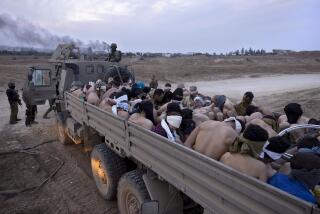War Brings Advances in Protection and Care
- Share via
BAGHDAD — In a typical week, 35 wounded American troops are delivered to the Army Combat Support Hospital, a Green Zone building that once housed Saddam Hussein’s private medical facility. Two-thirds are victims of improvised explosive devices.
By far the deadliest threat to U.S. troops in Iraq, IEDs account for about 40% of combat deaths and more than half of all wounds. The military counted 10,593 IED attacks last year, an average of 29 per day, up from 5,607 attacks in 2004.
Ballistic eye protection, combined with medical breakthroughs unavailable in previous conflicts, has helped reduce the bloodshed inflicted by IEDs. Eye protection was not required when U.S. forces invaded Iraq three years ago. But after IEDs caused devastating eye injuries, virtually all commanders here began to require their troops to wear eye protection.
At the same time, the military has loosened eyewear regulations. Early in the war, soldiers resisted wearing clumsy, Army-issue goggles nicknamed “anti-pregnancy glasses” for their decidedly uncool appearance. They are now permitted to wear trendy Wiley or Oakley ballistic sunglasses.
Soldiers struck by IEDs while wearing eye protection “come out looking like a raccoon, and they may have first- and even second-degree burns,” said Air Force Lt. Col. Bryan Angle, an eye surgeon who has tested ballistic glasses by shooting them with a .22-caliber gun. “But around the eye itself, there’s really no burns at all.”
The military also has performed an about-face on one of the oldest tools in combat medicine: the low-tech tourniquet. Discouraged in previous wars because they were believed to lead to amputation, tourniquets now are carried by all troops. Experience in Iraq has shown that tourniquets do not necessitate amputation, combat surgeons said.
“Tourniquets have changed from a measure of last resort to a measure of first resort,” said Maj. Brett Hampton, an orthopedic surgeon at the Baghdad hospital. “A typical upper-extremity wound that a soldier might die from in five minutes can be squelched by his battle buddy who has a tourniquet and knows how to apply it.”
Combined with improved bandages that have replaced gauze, and specialized training for medics and ordinary soldiers alike, surgeons say, tourniquets have saved troops who might have died or lost limbs in previous wars. New chemical clotting agents administered on the battlefield have also controlled hemorrhaging in patients who otherwise might have bled to death before reaching a hospital.
In addition, hypothermia is treated with Bair Hugger inflatable blankets pumped with warm air. A new rapid transfuser injects blood, saving lives by replacing lost blood far faster than the traditional drip method. And a tiny pump that allows patients to control their pain medication was implanted in a wounded soldier for the first time in November.
Most IED victims arrive with what surgeons call “polytrauma” injuries -- several types of wounds.
“Back home, you see a car accident and it will be blunt trauma or a head injury, or a single gunshot wound,” said Capt. Ed Dunton, the chief trauma nurse. “But here you get all that encompassed in a single patient: a head injury along with blunt trauma along with penetrating trauma.”
Because soldiers can be stabilized and moved so quickly, surgeons leave wounds open after cleaning them. That saves time and allows the wounded to be flown out of Iraq as quickly as possible. Speed is especially crucial for IED victims, who tend to have dirt and roadside debris embedded in their wounds.
Even serious abdominal wounds are left open with the help of a “wound vac,” a tube-and-pump device that creates a vacuum over an open wound. The wound is packed with sponge-like dressings and sealed with a thin, clear plastic so that it can be cleaned and drained regularly.
Lt. Col. Lawrence Lepler, an intensive care doctor in Baghdad, calls the hospital there, with 74 beds, “a souped-up ER.” The facility, which treats American and Iraqi civilians in addition to U.S. troops, is the world’s fifth-busiest trauma center, said Col. Peter Nielsen, the Baghdad hospital commander.
Most wounded soldiers have a good chance of survival because they tend to be young, strong and in exceptional physical condition -- “relatively indestructible,” as Hampton put it.
“It’s amazing,” said Maj. Tim Nunez, a surgeon. “They come in talking. They have these horrendous injuries and they’re actually sitting and talking to you.”
While treating one critically wounded soldier, Nunez said, he asked a medic whether the patient was still breathing. The soldier sat up and cracked, “Well, that’s not a good sign.”
“This hospital,” Nunez said, “is a surgeon’s dream.”
*
(BEGIN TEXT OF INFOBOX)
How they were hurt
Most of the Americans wounded in Iraq have been the victims of explosive devices similar to mines used in earlier wars. Here’s the breakdown of the causes of wounds through March 25:
Explosive devices 57%
Mortars/rockets 11
Other weapons 11
Weapons effect* 9
Other reasons** 4
Not reported 8
* Shrapnel, concussion, etc.
** Includes blunt force, falls, stabbings and transportation-related wounds
-
Source: Department of Defense
More to Read
Sign up for Essential California
The most important California stories and recommendations in your inbox every morning.
You may occasionally receive promotional content from the Los Angeles Times.














